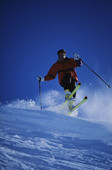
FRIDAY, Dec. 30 (HealthDay News) — To avoid serious winter sports injuries, skiers, snowboarders, sledders and skaters should take simple safety precautions, orthopedic experts say.
The U.S. Consumer Product Safety Commission reported that in 2010 more than 440,000 people were treated for injuries sustained from winter sports. Most injuries occurred among snowboarders and skiers. These two sports accounted for 292,000 of all winter sports-related injuries treated in hospitals or doctors’ offices. Another 91,000 people got hurt sledding and 58,500 people were injured while ice skating.
“When participating in winter sports, it’s important for participants to know the weather and terrain, to stay alert for changes, and to take a break when feeling pain or fatigue,” orthopedic surgeon Dr. A. Herbert Alexander said in a news release from the American Academy of Orthopaedic Surgeons (AAOS). “Before skiing, skating or sledding, make sure you’re dressed appropriately, in good physical shape, know and abide by the rules of the sport in which you’re participating, and seek medical attention immediately if necessary.”
Proper safety equipment, particularly helmets, can go a long way in preventing injuries. Children should always wear a helmet when engaging in any winter sport.
Experts from the AAOS offered these additional tips for preventing winter sports injuries:
- Check the forecast. Be aware of snow and ice conditions and predictions of adverse weather.
- Dress in layers. Wear several layers of light and loose clothing that is wind- and water-resistant. These layers will provide flexibility for changes in body temperature.
- Examine your gear. Be sure to check the condition of all protective equipment — such as goggles, helmets, gloves and padding — before venturing out. Skiers and snowboarders should also have their boots and bindings checked and adjusted by a ski shop that adheres to standards set by the American Society of Testing and Materials.
- Don’t go alone. Skiers and snowboarders should ski with a partner and stay within sight of each other. Always tell someone where you are going and what you will be doing. Bring your cellphone in case of emergency.
- Be aware of trail signs. Pay close attention to all signs and hazards. Tree runs should be avoided by anyone skiing or snowboarding alone. Backcountry skiers and snowboarders should not head out without a guide, should avoid avalanche zones and should carry proper safety equipment.
- Sled safely. Avoid sledding near streets, cars or other obstacles. Also be sure to sit in a forward-facing position and steer with your feet or the sled’s rope.
- Warm up. Take it easy when beginning a winter sport because cold muscles, tendons and ligaments are more easily injured.
- Stay hydrated. Drink plenty of water before, during and after outdoor activities, especially at high altitudes. Avoid drinking alcohol because it can increase the risk for hypothermia.
- Get physically fit. Be sure to stay in shape during the year before you jump into a winter sport. Anyone older than 50 years of age should visit their doctor before starting a new activity.
- Play by the rules. Know and follow the rules of each sport and avoid high-risk behavior. Take a lesson to learn how to use equipment properly and other techniques to reduce the risk of injury, including how to fall correctly.
- Be aware of frostbite and hypothermia. Early symptoms of frostbite include numbness and tingling in your fingers or toes as well as the inability to move well. When these symptoms appear, seek shelter and medical attention right away.
- Know when to stop. Many skiers are injured on their last run of the day. Avoid winter sports when you are too tired or in pain.
More information
The U.S. Centers for Disease Control and Prevention has more about winter safety.

